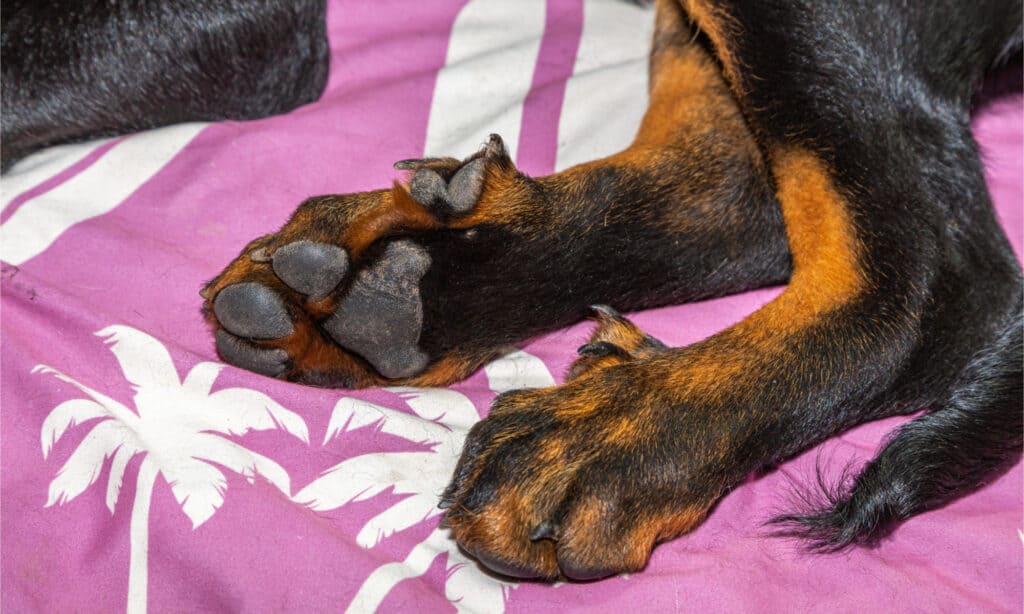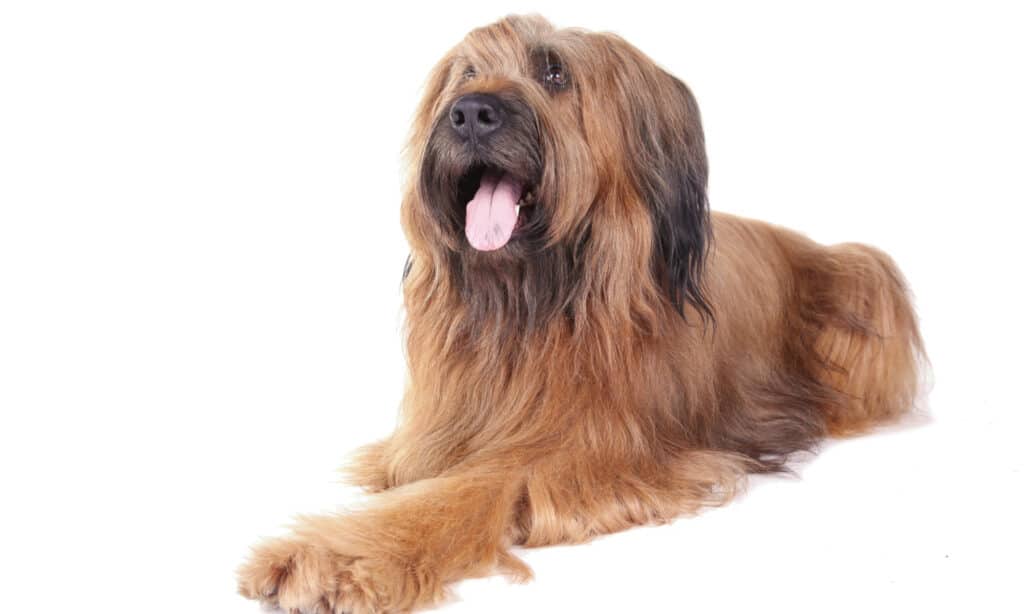As a dog owner, you may have noticed that your dog has five toes instead of four on its paws. But are dogs supposed to have four toes or five? Do all dogs have these extra toes? And if it’s only some dogs, is it a bad thing? Read on to learn more.
Do All Dogs Have Five Toes?
Most dogs have five toes on each front foot and 4 toes on each rear foot. The front feet include four regular toes and one dewclaw, while the back feet each have four regular toes. This makes for 18 toes in total! However, there are some breeds of dogs that will have even more toes (or dewclaws) with either single or double dewclaws on their back legs or front legs. In some cases, vets or breeders will choose to remove a dog’s dewclaws altogether. Some people consider this to be unnecessary and cruel to the dogs, while others consider it to be helpful for the dog in the long run.

The breed standard for the
Beauceron
requires them to have double dewclaws on both back legs.
©msgrafixx/Shutterstock.com
What Is a Dewclaw?
A dewclaw is a small, thumb-like toe with a nail that resides on the inside of a dog’s legs. This toe is higher up than all the others and doesn’t make contact with the ground like the other toes do. Some dogs will have front dewclaws while others with have rear ones and some dogs will have no dewclaws at all.
But if dogs descended from wolves and purebred wolves don’t have dewclaws, how did modern dogs obtain theirs? This is a good question and the answer likely lies in how humans interacted with their working dogs. It is very likely that humans helped encourage the growth and development of dewclaws as a way to help the earliest dogs perform their duties better.
The dogs needed to do things like climbing, digging, and making quick turns when running. Having the dewclaw likely gave these dogs an advantage which made them more likely to survive and go on to breed. Now, nearly all dogs are born with this trait.
Today, dogs use their dewclaws for various reasons. They may use it to grip and handle items such as bones or toys, dig into ice or other surfaces, use them to help pull themselves up out of the water, or even gently scratch an itchy eye. So if these extra toes are so helpful to dogs, why do some people choose to have them removed? Since dewclaws are located up higher on the dog’s leg, they run the potential risk of getting caught on things and ripped.
This could be incredibly painful for a dog, so some people have the dewclaw removed to prevent the chances of this happening. Sometimes shortly after a dog has been born, a breeder will have the dewclaws removed if they are going for a smoother look or if the dewclaws are not a part of the breed standard. In this case, the removal is simply for cosmetic purposes and some people are against it and see it as cruel.

The breed standard for Briards requires double dewclaws on both hind legs.
©Hysteria/Shutterstock.com
Which Dog Breeds Have the Most Toes?
The number of toes your dog has will typically depend on what breed your dog belongs to, as some will naturally have more toes than others. For example, the Norwegian Lundehund has developed six toes on each foot! This dog’s toes even have extra joints that work to help keep a firm grip on the rocks that they have to climb in order to hunt puffin birds. This is an example of evolution working to help these dogs do the things they need to do more efficiently.
Another dog breed that has extra dewclaw toes would be the Great Pyrenees. These dogs are known to be guard dogs that needed to be able to move very quickly if they had something they needed to chase. They’re strong mountain dogs and use their unique extra toes to help them gain traction—another case where the extra dewclaws served a distinct purpose.
A few other examples of dog breeds that have extra toes are as follows:
- Briard: This is a French dog breed that has double dewclaws low on its legs. The breed standard for this dog requires double on both of their rear legs.
- Estrela Mountain Dog: This is a large dog breed from the Estrela Mountains of Portugal. These dogs are bred to guard herds and homesteads and can have single or double dewclaws.
- Beauceron: This is a large French dog with rear dewclaws that are close to the ground. It uses its dewclaws to enable it to walk easily over both snow and ice. The breed standard for this dog requires that it has double dewclaws on both hind legs.
- Anatolian Shepherd Dog: This is a giant dog breed from Turkey that will almost always have a pair of double hind leg dewclaws.
- Saint Bernard: This may be one of the best-known and beloved dog breeds in the world. These dogs are gentle giants and were bred to help people that were stranded in the snowy Alps. They have single or double dewclaws but the breed standard does not require them.
- Icelandic Sheepdog: This is Iceland’s only native dog. They are bred for their guarding and herding abilities and can have single or double dewclaws. The breed standard does prefer that these dogs have double.
- Portuguese Sheepdog: This is an intelligent and lively dog breed that is devoted to guarding and herding livestock. These dogs have either single or double dewclaws.
As you can see, there are many different types of dog breeds that have extra toes. And even within those dog breeds, it is not always guaranteed that the dog will have any extra. Some dogs may have no extra toes, single extra toes, or even double extra toes. Therefore it varies widely and there isn’t necessarily a right or wrong when it comes to how many toes your dog has.

The breed standard for Icelandic sheepdogs prefers for them to have double dewclaws.
©Bildagentur Zoonar GmbH/Shutterstock.com
Should I Trim My Dog’s Dewclaws?
Yes. If your dog has either front or rear dewclaws it is important that you don’t forget about them when you trim their other nails. You want to trim them just like you would their regular nails because they can become easily overgrown if left untrimmed.
If your dog’s dewclaws are left to grow out they run the risk of getting caught on something and injuring your dog or growing back painfully into the dewclaw pad itself or a part of your dog’s leg. This can cause a tremendous amount of pain for your dog, so it’s best to make sure you keep them trimmed regularly along with their other nails.
When Are Dewclaws Removed?
Normally, dewclaws are removed by the dog breeder or by the breeder’s vet at about three to five days of age. When done at home, dewclaws can be clipped off by scissors or nail clippers. If done by a veterinarian, they are removed under local anesthesia, clamps, and a scalpel. It is important to note, however, that when the dewclaw is removed at this age, there can be a regrowth of the nail.
That is why is always best to have this procedure done by a veterinarian since they will remove all of the bones so that it doesn’t grow back over time. It is also much safer for the dog if you have it done by a vet, as you do not want to harm the dog or cause any pain. After this early age of the dog, dewclaws must be removed when the dog is sedated since it’s considered an amputation. Sometimes this procedure can be done at the same time as spay or neuter surgeries.
Is Removing Dewclaws Cruel?
Removal of the front dewclaws is usually regarded as an unnecessary procedure. It is not recommended to remove dewclaws unless there is a medical reason that truly warrants it. Some examples of this would include a severe injury (like a partially torn-off dewclaw), or a disease like cancer. This process is done under general anesthesia and will require pain medication, changing of bandages, physical activity restrictions, and wearing a cone post-op.
There is also the risk of infection afterward and scarring at the removal of the dewclaw site. In some cases, the regrowth of the dewclaw is still possible. Removal of the front dewclaws can even cause potential issues later on in a dog’s life. Without its front dewclaws, there seems to be a higher likelihood that the dog’s carpal (wrist) ligaments can stretch and tear easily. If this occurs, there is also the risk of laxity and arthritis as time goes on. This can create more stress on other joints in the dog’s legs and spine as it tries to compensate for the weakness in the carpus region.
On the other hand, removal of the rear dewclaws is often recommended if it is only attached by the skin and has a tendency to dangle. In this situation, removal of the rear dewclaws does appear to help prevent injuries, since it removes the chances of it getting caught on things and snagging or tearing. It can also help prevent ingrown dewclaw nails at the site. This procedure can be done at the same time that the dog is spayed or neutered since the dog will already be undergoing general anesthesia and will be on pain medications.
How Long Does It Take for Dewclaw Removal to Heal?
After a dog’s dewclaws have been removed it usually takes up to two weeks for the dog to heal. If the removal is done when the dog is just a few days old, the wound should heal in about three days with no sutures needing removal. If they were removed by a veterinarian and sutures closed, the vet will normally remove the sutures between 10 and 14 days after the procedure was done.
During the healing process, your dog will need to have its bandages changed daily on both the front dewclaws and back ones. This is to ensure that your dog doesn’t get an infection. Be sure to watch out for signs of pain or discomfort such as limping, constant licking or biting at the area, or touch avoidance. You should also check for swelling and bleeding and if you notice any, contact your veterinarian right away.
The photo featured at the top of this post is © cynoclub/Shutterstock.com
Ready to discover the top 10 cutest dog breeds in the entire world?
How about the fastest dogs, the largest dogs and those that are -- quite frankly -- just the kindest dogs on the planet? Each day, AZ Animals sends out lists just like this to our thousands of email subscribers. And the best part? It's FREE. Join today by entering your email below.
Thank you for reading! Have some feedback for us? Contact the AZ Animals editorial team.






